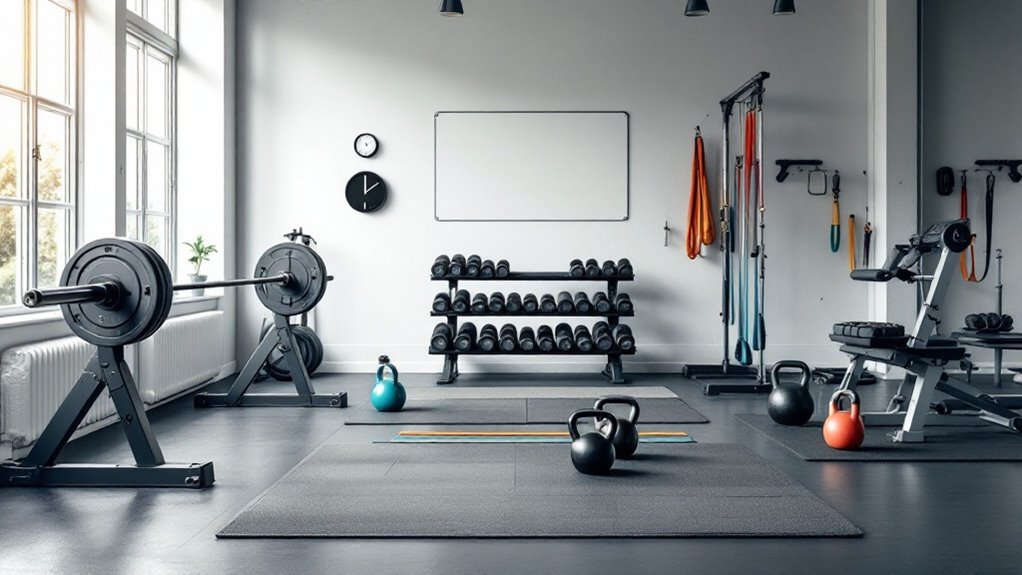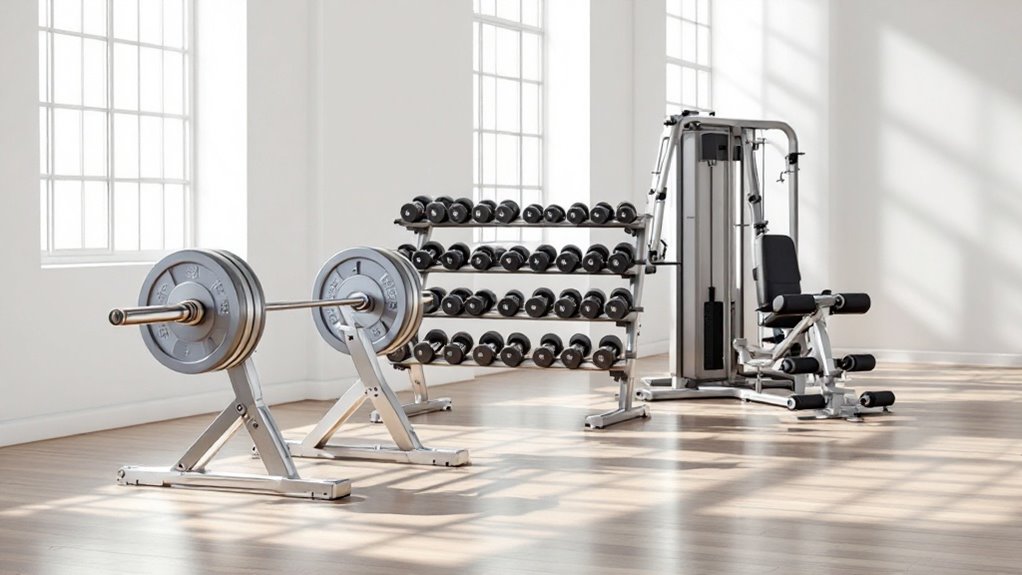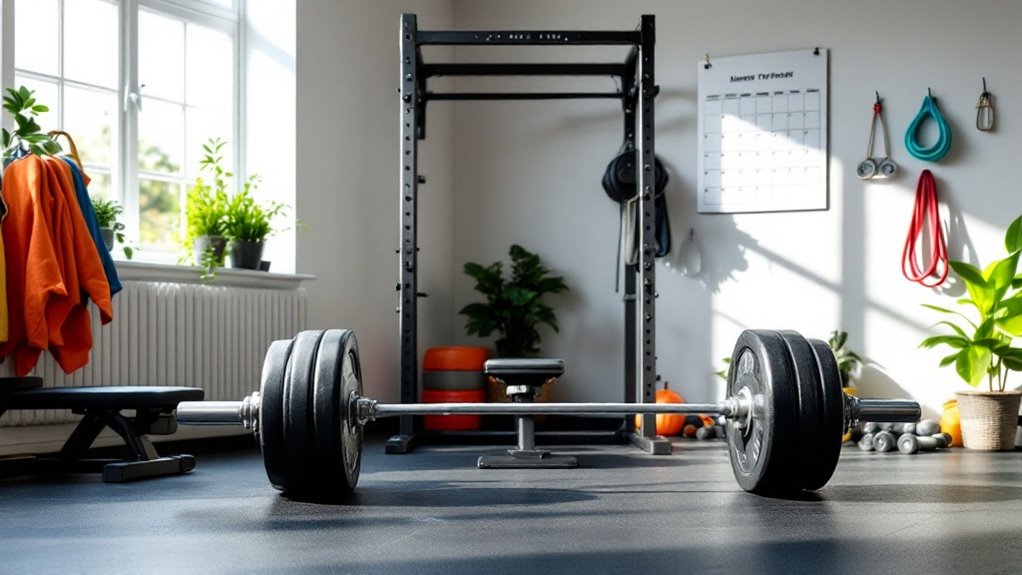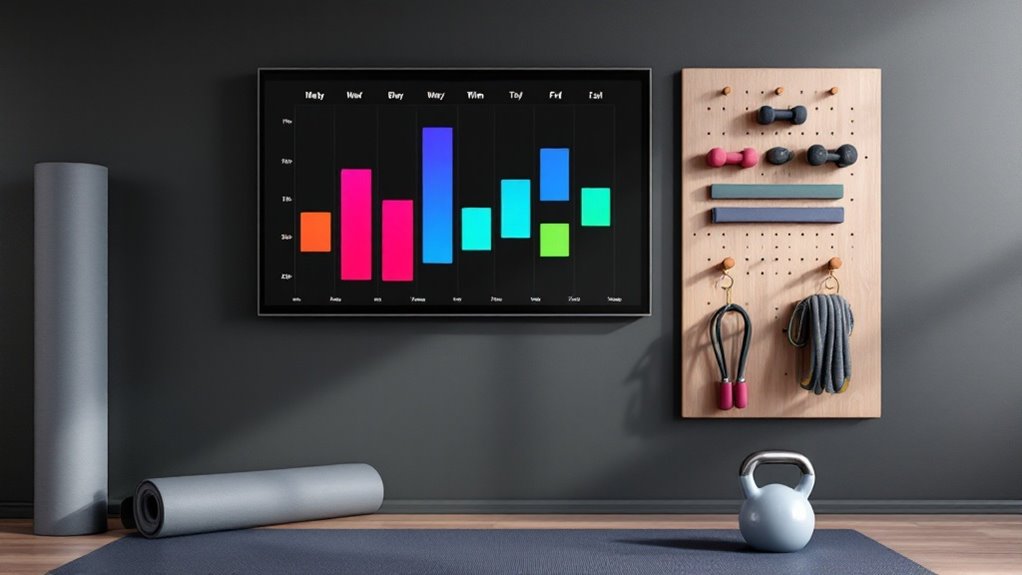Best Workout Split

The most effective workout split depends on individual goals, experience level, and schedule availability. Beginners benefit from full-body routines 3-4 times weekly to establish fundamental movement patterns. Intermediate lifters often succeed with upper/lower or push/pull/legs splits, training each muscle group twice weekly. Advanced athletes can handle higher frequency body-part splits 5-6 days per week. Strategic programming balances training volume with adequate recovery periods for ideal results. Understanding the science behind different splits reveals improved performance potential.
Key Takeaways
- Push-Pull-Legs split maximizes muscle recovery and allows optimal training volume while hitting each muscle group twice per week.
- Full-body workouts 3-4 times weekly are ideal for beginners and fat loss goals, focusing on fundamental movement patterns.
- Upper-Lower splits provide efficient training for intermediate lifters, allowing 48 hours recovery between similar muscle groups.
- The best split depends on your schedule, with 3-4 training days recommended for beginners and 5-6 for advanced athletes.
- Each muscle group should be trained 2-3 times weekly with 8-12 total sets for optimal strength and muscle growth.
Matching Your Training Split to Your Goals

How one structures their training can make or break their fitness journey. Selecting the right workout split requires coordinating training frequency, volume, and intensity with specific goals.
Research shows that workout splits allow training to be more effective and consistent than random exercise selection. For strength gains, focus on 3-5 reps of compound lifts 2-3 times weekly with ample recovery. Personal preferences matter when choosing workout splits that align with your schedule and motivation levels.
Muscle growth demands higher volume at 8-12 reps twice weekly per muscle group. Using proper periodization techniques helps prevent plateaus while maximizing muscle development over time.
For optimal hypertrophy, target each muscle group with focused volume work of 8-12 repetitions, scheduled twice per week.
Endurance athletes benefit from circuit-style training with higher repetitions and minimal rest periods.
Those pursuing fat loss should combine full-body resistance training with HIIT 3-4 times weekly.
The key is matching training variables to desired outcomes while maintaining consistent progressive overload and adequate recovery between sessions.
The Science Behind Different Split Routines

Scientific research has revealed compelling evidence about the effectiveness of various training splits in maximizing muscle growth and strength gains. Studies show that training each muscle group 2-3 times per week enhances hypertrophy, with full-body routines enabling higher frequency while maintaining appropriate volume. The push/pull/legs split has emerged as one of the most versatile approaches for both beginners and advanced lifters.
Research indicates that 3-5 sets per muscle group per session, totaling 8-12 sets weekly, produces excellent results. Full-body and upper/lower splits effectively distribute this volume compared to traditional body-part splits. Hybrid splits can provide an ideal balance between frequency and recovery for intermediate lifters. Training six days per week allows for optimal muscle group targeting while preventing burnout through structured rest periods.
The key lies in managing weekly volume while allowing adequate recovery between sessions, whether through full-body or split routines.
Common Training Splits and Their Benefits

Training splits provide athletes and fitness enthusiasts with structured approaches to organizing their workout routines for optimal effectiveness.
Women can achieve lean muscle mass without unwanted bulk through proper split programming.
A well-designed split ensures 48 hours of recovery between sessions targeting the same muscle groups.
The Push-Pull-Legs split maximizes recovery while delivering high training volume, making it perfect for those seeking strength and size gains.
The Upper-Lower split offers time efficiency and consistent progression for intermediate lifters, allowing targeted focus on specific body regions.
Full-body workouts excel for beginners, establishing fundamental movement patterns with lower volume per session.
Each split delivers unique benefits, from optimized recovery times to improved workout efficiency, allowing individuals to select the structure that best corresponds with their goals and experience level.
Body part splits deliver greater muscle definition by focusing intensively on one area at a time.
Creating Your Optimal Weekly Training Schedule

Creating an ideal weekly training schedule requires careful consideration of multiple factors, including workout intensity, recovery periods, and individual fitness goals. The best approach follows a structured pattern of alternating high-intensity (red), moderate (blue), and light (green) training days.
For most individuals, following a 1/2/3 or 2/2/2 split works effectively, spacing intense workouts at least 48 hours apart. Beginners should start with 3-4 training days per week, while advanced athletes can handle 5-6 sessions. Maintaining an average recovery score above 80% is essential for optimal training results. It's important to exercise more days than not during the week for optimal results. A six-month progression allows your body to gradually adapt to increasing workout intensities while minimizing injury risk.
Time-blocking workouts helps maintain consistency, with specific durations allocated for different training styles: 20-45 minutes for HIIT, 45-60 for strength, and 30-90 for endurance work.
Frequently Asked Questions
Can I Switch Between Different Workout Splits During the Same Training Program?
Switching between workout splits within a training program is effective and beneficial when done strategically.
Research shows that changing splits every 4-6 weeks helps prevent plateaus and maintains muscle adaptation. The key is maintaining progressive overload while allowing adequate recovery between changes.
Athletes should focus on keeping core compound exercises consistent across splits while adjusting volume to optimize gains and prevent overtraining.
How Should I Adjust My Workout Split When Traveling or Missing Gym Days?
When traveling or missing gym days, adjusting workout splits requires strategic adaptation.
Focus on compound movements and bodyweight exercises to maintain fitness levels. Reduce total volume while preserving key lifts, and utilize portable equipment like resistance bands.
Schedule recovery periods between muscle groups, pushing missed sessions into subsequent weeks.
Consider local gym day passes or outdoor training spaces to maintain consistency.
What Supplements Work Best With Each Type of Training Split?
Each split requires specific supplementation for ideal results.
Full-body workouts benefit from rapid energy sources like caffeine and creatine.
Hypertrophy splits need muscle preservation supplements like BCAAs and HMB.
PPL routines thrive with performance boosters like caffeine for power days and beta-alanine for endurance.
Upper-lower splits perform best with recovery aids like creatine and nitric oxide enhancers between intense sessions.
Should Beginners Start With Full-Body Workouts Before Moving to Advanced Splits?
Picture a novice climber attempting to scale Mount Everest without first mastering basic mountaineering skills.
Similarly, beginners should start with full-body workouts to build fundamental strength, perfect form, and develop mind-muscle connections. This foundation creates a sturdy platform for future progression.
Full-body training teaches proper movement patterns, improves overall coordination, and builds the necessary baseline strength before advancing to more complex split routines.
How Do I Maintain Muscle While Reducing Workout Frequency Due to Injury?
Maintaining muscle during injury requires strategic adaptation of training variables.
Focus on preserving intensity while reducing frequency and volume. Train affected muscle groups every 7-14 days at near-maximal effort, which retains 90-95% of gains.
Incorporate high-protein nutrition (1.2-2.2g/kg/day), heat therapy, and vitamin E supplementation.
Use joint-friendly alternatives like machines and bands while allowing adequate recovery between sessions.
Final Thoughts
Selecting the ideal workout split ultimately depends on individual goals, schedule constraints, and recovery capacity. Like programming a vintage Commodore 64 computer, the right training formula requires precise inputs to generate desired outputs. Whether choosing full-body, push-pull-legs, or body part splits, consistency and progressive overload remain fundamental. Success comes from coordinating training frequency with recovery ability while maintaining sustainable workout patterns that support long-term progress.


